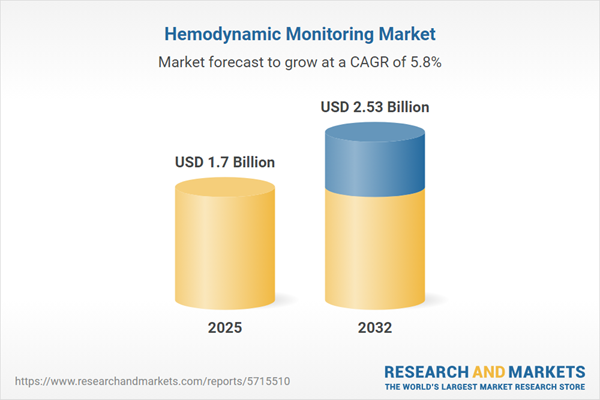Speak directly to the analyst to clarify any post sales queries you may have.
The hemodynamic monitoring market is at the forefront of digital transformation in healthcare, empowering senior leaders to drive performance, operational agility, and clinical excellence across care environments.
Market Snapshot: Hemodynamic Monitoring Market Growth
The global hemodynamic monitoring market reached a value of USD 1.60 billion in 2024 and is forecasted to expand to USD 1.70 billion in 2025, with further growth anticipated up to USD 2.53 billion by 2032 at a CAGR of 5.84%. Organizational investments in digital health platforms and patient-focused care continue to propel this market, with healthcare institutions accelerating the adoption of advanced monitoring systems to meet changing clinical demands. Workflow modernization, combined with an increasing preference for minimally and non-invasive monitoring technologies, has improved device interoperability and enabled flexible responses to both in-hospital and outpatient requirements. Senior decision-makers are recognizing these solutions as critical assets for sustaining operational resilience and meeting dynamic regulatory and patient expectations in today's complex care landscape.
Scope & Segmentation of the Hemodynamic Monitoring Market
- Product Types: Esophageal Doppler monitors, bioimpedance and bioreactance systems, pulse wave transit time platforms, pulmonary artery catheters, pulse contour analysis tools, console ultrasound systems, and portable ultrasound units all address specific clinical requirements and enable precise patient monitoring across diverse scenarios.
- Applications: Devices are deployed in ambulatory care centers, emergency departments, operating rooms, and intensive care units, ensuring standardized oversight and prompt, informed decision-making in acute and routine care episodes.
- End Users: Hospitals, ambulatory surgical centers, home care providers, and research laboratories leverage these technologies for clinical accuracy, patient safety, and measurable quality enhancements.
- Technologies: Invasive, minimally invasive, and non-invasive platforms offer the flexibility to align with patient acuity and institutional protocols, promoting broader access and clinical compliance.
- Patient Categories: Tailored monitoring solutions support adult, pediatric, and neonatal populations, helping teams adhere to safety requirements and address unique risk factors across age groups.
- Distribution Channels: Models such as direct purchasing, distributor partnerships, and online procurement solutions allow for responsive sourcing and dependable system deployment, maintaining resilience during fluctuations in market demand.
- Regions: The Americas, Europe, Middle East & Africa, and Asia-Pacific each offer unique infrastructure landscapes and regulatory climates, making region-specific strategies vital for optimized adoption and implementation.
Key Takeaways for Senior Decision-Makers
- The integration of wireless sensors and AI-enabled analytics equips care teams to act quickly and derive actionable insights throughout the patient journey, enhancing early intervention capabilities.
- Adoption of minimally and non-invasive technologies elevates patient comfort, expands the reach of real-time monitoring, and adapts effectively to both acute and patient-centric outpatient settings.
- Collaboration among critical care, anesthesiology, and cardiology stakeholders standardizes processes and improves outcomes by supporting unified protocols and efficient resource allocation.
- Diversified supplier relationships and strengthened distributor partnerships ensure device availability, maintaining workflow continuity even as external disruptions impact logistics and procurement cycles.
- Investments in advanced digital infrastructure and robust staff training are central to smooth technology integration, supporting continuous performance improvements and successful organizational adaptation.
Tariff Impact on Supply Chain
Changing U.S. tariffs have increased input costs for device components, prompting healthcare organizations to broaden supplier networks and adopt flexible procurement methods. These approaches protect against supply chain vulnerabilities and maintain access to critical medical equipment during periods of disruption or volatility.
Methodology & Data Sources
This analysis is grounded in data gathered from expert interviews, comprehensive market surveys, and validated secondary research. Employing statistical techniques and rigorous analysis, this report delivers reliable, actionable insights for strategic planning in the hemodynamic monitoring sector.
Why This Hemodynamic Monitoring Market Report Matters
- Enables leaders to adapt confidently to regulatory changes, optimize investments in emerging technologies, and redesign workflows in response to evolving healthcare market trends.
- Provides strategies for reinforcing medical supply chains, supporting innovation, and meeting broad patient care requirements through enhanced operational resilience and agility.
- Offers targeted insights into regional infrastructure characteristics and end-user priorities, guiding effective market entry and long-term business development efforts for executive decision-makers.
Conclusion
This report delivers the critical guidance healthcare executives need to drive care innovation, streamline operations, and make informed decisions in the fast-changing hemodynamic monitoring market.
Additional Product Information:
- Purchase of this report includes 1 year online access with quarterly updates.
- This report can be updated on request. Please contact our Customer Experience team using the Ask a Question widget on our website.
Table of Contents
3. Executive Summary
4. Market Overview
7. Cumulative Impact of Artificial Intelligence 2025
Companies Mentioned
The companies profiled in this Hemodynamic Monitoring market report include:- Edwards Lifesciences Corporation
- General Electric Company
- Koninklijke Philips N.V.
- Masimo Corporation
- Drägerwerk AG & Co. KGaA
- Nihon Kohden Corporation
- Mindray Medical International Limited
- Medtronic PLC
- Canon Medical Systems Corporation
- Baxter International Inc.
Table Information
| Report Attribute | Details |
|---|---|
| No. of Pages | 182 |
| Published | November 2025 |
| Forecast Period | 2025 - 2032 |
| Estimated Market Value ( USD | $ 1.7 Billion |
| Forecasted Market Value ( USD | $ 2.53 Billion |
| Compound Annual Growth Rate | 5.8% |
| Regions Covered | Global |
| No. of Companies Mentioned | 11 |









